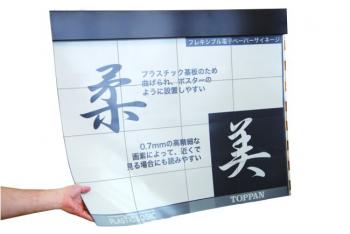Cambridge University's Graphene Centre and Plastic Logic have signed a research collaboration agreement on graphene in flexible plastic electronics. This strategic agreement has several activities and goals, one of them is to develop graphene as a transparent, highly conductive layer for plastic backplanes for unbreakable LCD and flexible OLED displays.
 Flexible E Ink panel by plastic logic
Flexible E Ink panel by plastic logic
The two other research goals are to develop new transistor structures that use graphene-like materials as the active layer and to exploit the commercialization of graphene for flexible electronics.
Plastic Logic is mostly focused on e-paper displays, and the company has recently announced an OTFT-based flexible 42" e-paper (E Ink) display, made from sixteen 10.7" flexible panels tiled together. Plastic Logic will collaborate with Toppan printing to bring these new displays to the market. Plastic Logic received a $700 million investment from RUSNANO back in 2011.
The CGC was established in early 2013 with a £12 million grant from the UK government. It aims to develop new mass production high-quality graphene production processes and also work on potential applications (such as energy storage and, as of today, flexible plastic electroncis).
Comments
Sorry, but how exactly will Graphene make plastic displays stronger and unbreakable?
What makes the display "unbreakable" is not the Graphene (which is a single-atom thick sheet of carbon atoms) it is the fact that you replace the currently used glas substrate with one made from plastic.
The other thing is that it is not entirely true that ITO can't be put on plastic: It can (albeit with some performance losses). The real issue with ITO is that it is not really flexible. So if you want flexible displays you do need something else, but here Graphene is just one of the options others include silver nanowires, PEDOT:PSS and so on...
Still is good to see that more companies are joining this field, but just to be blunt: Samsung, Sony and others have shown Graphene as transparent electrodes years ago so it's not as if the idea itself is revolutionary new ;)
Today is broken glass in smartphones we biggest problem with this electronic devices which getting larger displays for every generation.
With graphene not only instead of ITO for capacitive display multitouch property but also as material for TFT, will make Amoled displays much more unbreakable than todays displays with glass in both in backend and frontend of todays displays.
Silver nanowires will be a future environment problem because of that silver ions are toxic for all waterliving organisms.
If this nanowired displays would throwned away in the environment.


Great news!
Because graphene in TFT and electrodes for capacitive displays will make plastic displays much stronger and unbreakable and displays in feather weight!
Chemical professor James Tour at Rice University explain in this 2:38 min. short video about that ITO can´t fix on plastic substrate but graphene do and therefore is graphene also suitable as elctrode material in capacitive displays.
http://www.youtube.com/watch?v=d-P6_BMsHSw